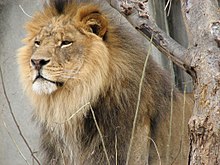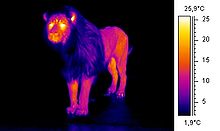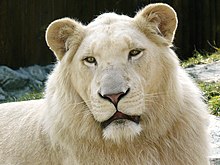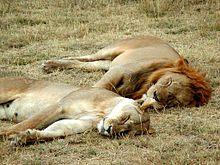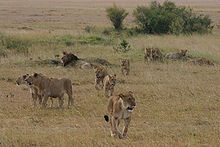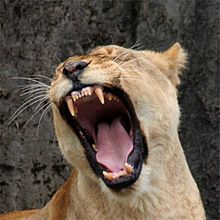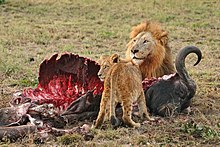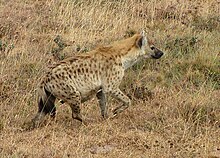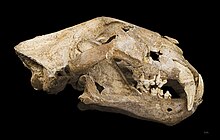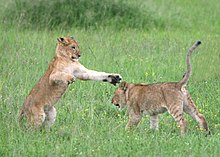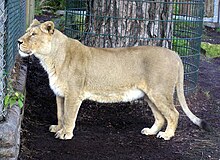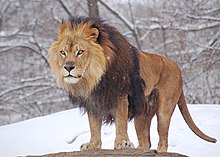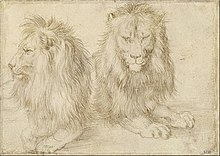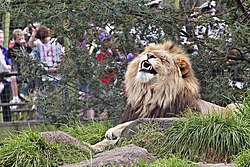Panthera leo
The lion (Panthera leo) is a carnivorous mammal of the felid family and one of the five species of the genus Panthera. Wild lions live in increasingly dispersed and fragmented populations in sub-Saharan Africa (except for the jungle regions of the Atlantic coast and the Congo Basin) and a small area of northwestern India (a critically endangered population in the park Gir Forest and surrounding areas), having disappeared from the rest of South Asia, West Asia, North Africa and the Balkans in historical times. Until the end of the Pleistocene, approximately ten thousand years ago, of the large land mammals, the lion was the most widespread after humans. Its distribution covered most of Africa, much of Eurasia, from western Europe to India, and in the Americas, from the Yukon River to southern Mexico.
If they survive the hardships of childhood, lionesses living in a safe habitat, such as Kruger National Park, can often live to the age of twelve to fourteen, while male lions rarely live longer than eight years. However, there are known cases of lionesses that have lived up to twenty years in the wild. In captivity, both males and females can live for more than twenty years. They usually live in savannahs and grasslands, even when they can enter shrubby and wooded areas. Lions are especially social animals compared to other cats. A pride of lions is made up of females in a family relationship, their cubs, and a small number of adult males. Lionesses usually hunt together, in groups, attacking mainly large ungulates. The lion is a top predator and key, although it can have scavenging behavior if given the opportunity. Although lions do not normally hunt humans selectively, some of them can become cannibals and seek human prey.
The lion is a vulnerable species and, in its African range, has suffered a possibly irreversible population decline of between 30% and 50% over the last two decades; they are not viable outside of delimited reserves and national parks. Although the cause of this decline is not fully understood, habitat loss and conflict with humans are currently major concerns. Lions have been kept in captivity since the days of Ancient Rome, and since the late 18th century they have been a highly sought after species on display in zoos around the world. The zoos themselves are collaborating on breeding programs to protect the threatened Asian subspecies.
The males are very easy to distinguish thanks to their mane, which makes their head one of the most widely known animal symbols in human culture. It appears very often in literature, sculpture, painting, on national flags, and in contemporary films and literature.
Name and etymology
The lion's name, which is similar in many Romance languages, derives from the Latin leo, related to the Ancient Greek λέων (léōn). The Hebrew word lavi (לָבִיא) may also be related, as well as the ancient Egyptian rw. The lion was one of many originally described species, as Felis leo, by Carlos Linnaeus in his work of the XVIII century Systema naturae. The generic component of its scientific name, Panthera, is often assumed to derive from the Greek pan- ('all') and ther ('beast'), but it could be a folk etymology. Although it came to Spanish through the classical languages, panthera is probably of East Asian origin, with the meaning of 'yellowish animal' or 'whitish yellow'.
Morphology
The lion is the second largest living cat after the tiger. With powerful limbs, a strong jaw, and three-inch canine teeth, the lion can kill large prey. Lions have the highest percentage of skeletal muscle (striated) among all mammals, at nearly 59%, which is 1.31 times the average for other mammal species. Lion coloration ranges from light beige to yellowish, reddish, or brownish brown. umber. The underparts are usually paler and the hair on the tail end is black. Lion cubs have a spotted pattern that fades with age, although it can sometimes be seen on the legs and belly, especially in lionesses.
Lions are the only cats that display sexual dimorphism as adults. Males have a thick mane, also called a guedeja or vedeja, which females lack. The color of the mane ranges from blonde to black, usually darkening as the lion ages.
The natural weight of adult lions generally varies between 180-190 kg for males and 120-182 kg for females; lions tend to be different sizes depending on the environment and area they inhabit, something that results in a great variety of registered weights. For example, Southern African lions tend to weigh 5% more than East African lions overall. Head and body length is 205 to 334 cm in males and 180 to 270 cm in females; height at shoulder reaches 125 cm in males and females reach 107 cm. The tail is 90 to 105 cm in males and 70 to 100 cm in females. The longest known lion was a 12 ft 7.5 in (3.847 m) male. Another black-maned male captured by G. Gladney near Mucsso (in southern Angola) in October 1973 measured 3.6 meters long. Excessively heavy lions have been reported, such as one shot by Daniel Boone at 411 kg; two lions killed in the Tanganyika lagoon that were killing farm animals were weighed at 313 and 363 kg. One lion that was captured in the wild and bred in captivity weighed in at 395 kg; there was also a case where a lion was shot and documented at 340 kg by Charles Pitman in his book called The African Game wardens. Although the lion The largest documented and accepted by science was a 313 kg male, killed by Lennox Anderson in 1936 at Hectorspruit in the eastern Transvaal, other lions in this same area (eastern Transvaal) have reached large weights close to 250 kg without content stomach (which may represent 20% of the animal's weight). Also found in this area was the largest recorded skull for any modern lion or felid in the world, at 46.68 cm long. However, the average weight of the lions that inhabit southern Africa ica, in places like the Kruger National Park, Zimbabwe or the Kalahari, stands at about 187.5 to 193.3 kg for males and about 124.2 to 139.8 kg for females. In East Africa the weight Male lions in the Serengeti average 182 kg and those in the Ngorongoro Conservation Area average 212 kg. Captive lions are often larger than wild ones—the largest lion ever documented is a male in a zoo who weighed 454 kg.
In both males and females, the end of the tail has a brushlike tuft of hairs. In some lions, the mat conceals a "spine" or "spur" about 5 mm long, formed by the fusion of the end sections of the tail bone. The lion is the only feline to have a tail with a tuft of hair—the function of the tuft and spur is unknown. The mat is absent at birth, but develops after 165 days of life and is easily observable at 7 months.
Mane
The male lion's mane, unique among cats, is one of the most characteristic features of the species. It makes the lion appear larger, causing excellent intimidation, which aids the lion in combat against other lions and against the main competing species of lions in Africa, the spotted hyena. The presence, absence, color and size of the mane are associated with genetic conditions, sexual maturity, climate and testosterone production; as a general rule, the darker and denser the mane, the healthier the lion. Research in Tanzania also suggests that mane length indicates success in fighting between related males. Individuals with a darker mane may have a longer reproductive lifespan and higher pup survival rate, although they suffer in the hottest months of the year. In groups dominated by a coalition of two or three males, it is possible that lionesses tend to want to mate more with lions that have a thicker mane.
In the past, scientists believed that the different status of some subspecies could be justified by morphology, including the length of the mane, for example to identify subspecies such as the Atlas lion or the Cape lion. However, research has shown that environmental factors influence the color and size of the lion's mane, as does ambient temperature today. The cooler ambient temperatures in European and North American zoos, for example, can give place to a thicker mane. Thus, the mane is not a suitable marker for identifying subspecies. However, males of the Asiatic subspecies are characterized by having less dense manes than average African lions.
Maneless male lions have been observed in Senegal and Kenya's Tsavo East National Park, as well as the maneless male white lion, native to Timbavati. Castrated lions have minimal manes. Manelessness has sometimes been observed in inbred populations of lions, which also causes poor fertility.
Many lionesses have a sort of collar that can be apparent in certain postures, which has sometimes led to the fact that in sculptures and drawings, especially in ancient art, the collar of lionesses is sometimes misinterpreted as the mane of the male. However, it differs from the mane in that it is at jaw level (below the ears), in that the hairs are much shorter, and often not noticeable, while the mane extends above the ears., often covering them completely.
Females have been observed with a mane very similar to that of the males and even females attempting to mate with other females. This phenomenon seems to be due to high levels of testosterone in these animals.
Cave paintings of the extinct cave lions of Europe show only lions without manes, or with a simple trace, suggesting that they were maneless. Perhaps, the protagonists of the paintings are probably females hunting (since which are depicted in hunting scenes), so these images do not allow us to reach a reliable conclusion about whether the males had manes. The illustrations suggest that this lion used the same social organization and hunting strategies as modern lions.
White lions
The white lion is not a distinct subspecies, but a leucistic color variety, which causes a paler fur coloration, similar to that of white tigers; this phenomenon is the inverse of melanism, which causes the coloration of black panthers. White Transvaal lions (Panthera leo krugeri) have occasionally been found in and near Kruger National Park and the adjacent Timbavati Private Game Reserve in eastern South Africa, but are easier to spot. found in captivity, since breeders expressly select them. The unusual cream color of their fur is due to a recessive gene. Supposedly, they have been bred in camps in South Africa to be used as hunting trophies.
Confirmation of the existence of white lions came in the late 20th century. For centuries it had been believed that the existence of the white lion was nothing more than a legend that circulated in South Africa, where it was said that the white fur of the animal represents the goodness present in all animals. The first sightings occurred in the early 1900s and continued infrequently for nearly fifty years, until a litter of white lion cubs was discovered in the Timbavati Game Reserve in 1975.
Biology and behavior
Lions spend much of their time resting and are inactive for about 20 hours a day. Although they can be active at any time, their activity usually peaks at sunset, with a period of socializing, licking, and defecating.. Intermittent periods of activity occur during the night hours until dawn, when lions hunt most frequently. They spend an average of two hours a day walking and 50 minutes eating.
Organization of groups
Lions are carnivorous predators with two types of social organization. Some are residents living in groups called pods. The group usually consists of approximately five or six related females, their offspring of both sexes, and one or two males known as the 'coalition', which mate with adult females (although extremely large groups of up to thirty individuals have been observed). The male coalition in a group usually consists of two males, but can increase to four and then back down. Males are expelled from their maternal group when they reach maturity.
The other type of social organization is that of "nomads", who move through large territories either alone or in pairs. Pairs are more frequent between related males. It should be noted that a lion can change its lifestyle; nomads can become residents and vice versa. The males have to go through this lifestyle and some are never able to join another group. A female that becomes nomadic has much more difficulty joining a new group, as the females in a group are related and reject most attempts by other unrelated females to join their family group.
The area occupied by a pride is called the "pack area", while that occupied by a nomad is called the "territory". Males associated with a pride tend to stay on the edge of the area, patrolling his territory. It is much debated why sociability (the most marked in all felid species) has developed in lionesses. Greater hunting success seems an obvious reason, but this fact is not the only one, since it also causes non-hunting members who are dedicated to the care of the offspring to reduce the intake of calories per capita. The health of the hunters is the main need for the survival of the pack, so they are the first to devour the prey in the same place where it has been hunted. Other benefits include possible kin selection (it is better to share food with a related lion than with a stranger), protection of cubs, maintenance of territory, and mutual security in case of injury and starvation.
Lionesses do most of the hunting for their pride, being smaller, faster and more agile than males, as well as not having the voluminous and visible mane, which causes excessive heat during physical exertion. They act as a coordinated group to increase the success of their hunts. However, males have a tendency to dominate the kill once the lionesses have taken the kill (in fact, they tend to share the kill more with the cubs than with the lionesses) and rarely share what they have killed themselves. The smallest prey is consumed in the place where it has been hunted, so that it is shared among the hunters; when the prey is larger, it is often dragged into the pack's territory. Large prey are more often shared, although pack members often continue to act aggressively towards each other, trying to eat as much as they can.
Both males and females defend the herd from intruders. Some lions often lead the defense against intruders, while others stay behind, providing other services to the group. An alternative hypothesis is that there is some kind of reward associated with being the leader who drives out intruders. The male or males often defend the group from outside males trying to take over the herd. Females form a stable social unit and do not tolerate other females; the female composition of a group only changes with the birth or death of lionesses, even when some females leave the pride and become nomadic. Instead, subadult males leave the pride as soon as they reach maturity, at the age of about 2-3 years.
Hunting and diet
Lions are powerful animals that often hunt in coordinated packs, besieging their chosen prey. However, they do not have particularly high resistance - for example, the heart of a lioness only represents 0.57% of its body weight, and that of a male 0.45% - while the heart of a hyena represents approximately 10% of their body weight. Thus, although females can reach a top speed of around 59 km/h, they can only do so in quick but short accelerations, so they must be near the prey before starting the attack. They take advantage of factors that reduce visibility; most prey is hunted near some hiding place from the lionesses, or at night. They stalk the victim undetected, until they are at a distance of approximately 30 meters or even less. Generally, several lionesses work as a team and surround potential prey from different points. Once they have surrounded the group, they usually attack the weakest prey. The attack is short and powerful, attempting to grab the victim with a quick acceleration and final leap. The prey usually dies by strangulation, or by suffocation, in which the lion covers the mouth and nose of its prey, although smaller prey can be killed with a simple blow from the paws.
Lion prey is primarily large mammals, with a preference for wildebeest, impala, zebra, buffalo, and warthog in Africa, and nilgos, wild boar, and various species of deer in India. Lions also hunt many other species depending on availability, which mainly concerns ungulates weighing between 50 and 300 kilograms, such as kudus, harpsichords, Cape oryx, and elands. They sometimes hunt relatively small species such as gazelles. Thomson's or the jumping gazelle. Lions living near the Namibian coast prey heavily on seals. Lions hunting in packs are capable of taking most animals, even healthy adults, but rarely attack very large prey such as adult giraffes., since they run the risk of getting hurt.
Many statistics collected in various studies show that lions normally feed on mammals between 190 and 550 kg. Wildebeest are their preferred prey (accounting for nearly half of lion prey in the Serengeti), followed by zebras. Most adult hippos, rhinos, and elephants are generally excluded, as are smaller and smaller gazelles and impalas. other agile antelopes. However, in some regions they frequently hunt giraffe and buffalo. They also occasionally hunt for hippos, while they tend to avoid adult rhinos. Although warthogs weigh less than 190 kg, they are also often hunted, depending mainly on their availability. In some areas, they specialize in hunting rare species, as is the case in Chobe National Park, specifically in the area from the Savuti River, where they hunt elephants. Park guides reported that lions, driven by extreme hunger, began hunting baby elephants, later moving on to adolescents and sometimes adults on nocturnal hunts, when the sight Elephants are poor. Giraffes are routinely hunted in Kruger National Park. Lions also attack cattle; specifically in India, where bovines form an important part of their diet. They are capable of killing other predators such as leopards, cheetahs, hyenas, and wild dogs, although (unlike most felids) they do not usually devour their competitors. after killing them. They also feed on carrion of animals that died of natural causes or victims of other predators. A lion can eat up to 30 kg of meat while sitting next to the prey, but if it is unable to eat it whole, it will rest for a few hours. to continue devouring it later. On hot days, the group may retreat to the shade, leaving one or two males to keep an eye on the game. An adult lioness needs an average of about five kilograms of meat per day and a male about seven.
Because lionesses hunt in open spaces where prey can easily see them, hunting in a pack increases the chances of a successful hunt, most particularly with larger prey. Teamwork also allows them to more easily defend their game against predators such as hyenas, which can be attracted to the presence of vultures from miles away in the open savannah. Lionesses do much of the hunting. In typical hunting, each lioness has a preferred position in the group, stalking prey from the sides and then attacking, or moving a shorter distance in the center of the group and catching prey fleeing from other lionesses.
The males in a group do not usually participate in the hunt, except for large game such as giraffe and buffalo. Males without a group are forced to hunt alone, although males hunting in groups have also been reported.
The young begin to exhibit hunting behavior at the age of about three months, although they do not participate in hunting until they are almost a year old. They begin to hunt effectively when they approach two years of age.
Reproduction and Life Cycle
Most lionesses have reproduced by four years of age. Lions do not mate at any particular time of year, and females have numerous oestrus phases each year. As in other felids, the penis the male has spines pointing backwards. When the penis is withdrawn, the spines rub against the walls of the female's vagina, which can cause ovulation. A lioness may mate with more than one male when in heat; during the mating period, which can last several days, lions have been observed copulating 157 times in a 55-hour period. They breed very easily in captivity.
The gestation period lasts an average of 110 days and the female gives birth to a litter of between one and four pups in an isolated burrow, which can be found in areas of scrub, reed beds, caves or some other protected area, usually separated from the rest of the herd. Females frequently hunt alone while the young are still helpless, staying relatively close to the burrow where the young are found. Young are born blind and do not open their eyes for about a week after birth. They weigh between 1,200 and 2,100 g at birth and are virtually defenseless. They begin to crawl within a day or two of birth, and to walk when they are about three weeks old. The lioness moves the cubs to a new location numerous times a month, carrying them one by one by the scruff of the nape. This movement is intended to prevent its scent from accumulating in the same place and thus avoid the attention of potential predators.
In general, the mother rejoins the group with her cubs when the cubs are nine to ten weeks old. However, sometimes this introduction to pride life occurs earlier, especially if other lionesses have given birth in the same time. For example, lionesses in a group often synchronize their reproductive cycle in order to cooperate in breeding and nursing cubs (once they have passed the initial phase of isolation with their mother), which suckle indiscriminately from any of the cubs. female caretakers of the group. In addition to offering greater protection, synchronization of births is also advantageous in that, since the pups are very similar in size, they have the same chance of survival. If a lioness gives birth to a litter of cubs a couple of months after another lioness, for example, then the younger cubs find it difficult to feed, as they are often dominated by the older ones. Therefore, starvation is more common among young hatchlings.
In addition to starvation, the cubs also face many other dangers, including being hunted by jackals, hyenas, leopards, martial eagles, and snakes. Even the buffaloes, if they catch the scent of the lion cubs, stampede towards the thicket or den where the cubs are, doing their best to trample the cubs to death while keeping the lioness at bay.. In addition, when one or more new males unseat the previous pride-associated male, they frequently kill existing pups, perhaps because females are not fertile and receptive until their pups grow up or die. In total, up to 80% of cubs die before reaching two years of age.
When they integrate with the rest of the pack, the cubs lack trust in any adult other than their mother. Even so, they soon begin to participate in the life of the group, playing with each other or trying to start playing with the adults. Lionesses who have cubs are more likely to be tolerant of other lionesses than those who don't. Male tolerance of pups varies: sometimes the male may patiently let the pups play with his tail or mane, while other times he may growl and chase the pups away.
Weaning occurs at six to seven months of age. Males reach maturity at three years of age, and at four or five years of age they are capable of challenging and displacing the adult male of another herd. They begin to grow old and weak no later than ten to fifteen years of age, if they have not already been severely injured defending their pack. Therefore, in captivity a lion can live thirty years; but in its wild habitat only males and sixteen females live up to twelve years. When the dominant male is driven out by his rival, he rarely regains his status within the pack and is forced into exile. The sooner they start breeding once they take control of a pride, the more reproductive success they will have before reaching old age and being banished by younger lions. Lionesses often try to fiercely defend the cubs against a usurping male, but are rarely successful. The usurper usually kills all the cubs that are less than two years old. Because females are weaker and lighter than males, pup defense may be more likely to succeed if three or four mothers in a pride unite against one male. Females whose young have been killed by the usurping male come into heat again in a few days.
Contrary to popular belief, it's not just males who are expelled from their pride and become nomads, although it is true that most females remain in their natal pride for their entire lives. However, when the herd becomes too large, the next generation of female calves may be forced to leave and find their own territory. Also, when a new male gains control of a herd, subadult individuals, both male and female, may be expelled. The life of a nomadic female is hard. She rarely gets her young to maturity, as they lack the protection of other pack members.
A scientific study found that both males and females could engage in homosexual relationships. Males form pairs for a few days and begin homosexual activity with affectionate nuzzling, leading to intercourse and shoving. One study found that approximately 8% of copulations occur between two males. Homosexual relations between females are believed to be quite common in captivity, but have not been observed in the wild.
Health
Although adult lions have no natural predators, evidence suggests that most suffer a violent death caused by humans or other lions. This is particularly true of males, who, as the pride's primary defenders, they are more likely to interact aggressively with rival males. In fact, although a male lion can reach the age of fifteen or sixteen if he manages not to be driven out by other males, most adult males do not live more than ten years. This is the reason why in the wild the average longevity of lions tends to be significantly lower than that of lionesses. However, members of both sexes can be injured or even killed by other lions when two prides with concurrent territories come into conflict.
Regarding parasites, it is known that several species of ticks usually infect the ears, neck and groin of most lions. Also, from the intestines of lions, the adult form of ticks has been isolated. various species of tapeworms. Lions contract tapeworm by eating the larval forms present in antelope meat.
In 1962, lions in Ngorongoro Crater were attacked by the stable fly (Stomoxys calcitrans); this caused the lions to end up covered in bald and bloody spots, while also being completely emaciated. Lions tried to escape the bites of the flies without success, climbing trees or crawling into hyena dens; many of them died or migrated, and the lion population there plummeted from seventy individuals to fifteen. A more recent outbreak, in 2001, killed six lions. Lions, especially those living in captivity, are vulnerable. distemper virus, feline immunodeficiency virus (FIV) and feline infectious peritonitis (FIP). Distemper is transmitted by domestic dogs and other carnivores; A 1994 outbreak in Serengeti National Park caused many lions to develop neurological symptoms, including seizures. During the outbreak, several lions died of pneumonia and encephalitis. FIV, which is similar to HIV, does not adversely affect lions, but its effect on domestic cats is sufficiently concerning that the Species Survival Plan recommend routine testing of captive lions. It is very common and endemic in several wild lion populations, but is virtually non-existent among Asiatic and Namibian lions.
Communication
When at rest, lions perform social acts through a variety of behaviors and display highly developed expressive movements. They have a set of facial expressions and body postures that are visual gestures. The most common peaceful gestures are head rubbing and social licking, which have been compared to primate grooming. Head rubbing, using the muzzle to caress another lion's forehead, face and neck, appears to be a kind of greeting, as it is often seen when an animal has been separated from the rest or after combat or conflict. Males tend to rub other males, while cubs and females rub other females. Social licking often occurs in combination with head rubbing; they are usually mutual and the recipient seems to show pleasure. The head and neck are the most commonly licked parts of the body, which could be for practical reasons, as a lion cannot lick these areas itself.
Their repertoire of vocalizations is also wide; variations in the intensity and pitch of sounds, rather than visual cues, seem to form the basis of communication. Lion sounds include snorting, grunting, hissing, coughing, meowing, barking, and of course, roaring. Lions tend to roar in a very characteristic way, beginning with a few long, low roars, which lead to a series of shorter roars. They usually roar at night; the sound, which can be heard from a distance of 10 km, serves to announce the presence of the animal. A lion is able, just by hearing the roar of other lions once, to go to the exact point of its origin at distances of up to at least 5 km. Regardless of whether they are hidden in the undergrowth and in silence; if they have remained motionless in the same place, it will find them. Lions have the loudest roar of all cats.
Interspecific relationships of predation
The relationship between lions and spotted hyenas in areas where they coexist is unique in its complexity and intensity. Both species are top predators that feed on the same prey, so they compete directly with each other. They frequently fight each other and steal game. Although the popular conception sees hyenas as opportunistic scavengers that take advantage of the hunting abilities of lions, the opposite is often the case. In Tanzania's Ngorongoro Crater, the population of spotted hyenas vastly outnumbers that of lions, who obtain a significant portion of their food by stealing hyena prey. However, the conflict between the two species goes beyond fighting for food. Among animals, territorial boundaries with other species are usually ignored. Hyenas and lions are an exception; they draw boundaries between themselves just as they would with members of their own species. Male lions in particular are extremely aggressive towards hyenas and have been observed hunting and killing hyenas without eating them. In turn, hyenas are one of the main predators of lion cubs and besiege lionesses to steal their cubs.
Lions tend to dominate smaller cats like cheetahs and leopards in areas where they are sympatric. They steal their prey, kill their pups and even adults when they get the chance. The cheetah has a 50% chance of losing its kill to lions or other predators. Lions pose a great danger to cheetah cubs and up to 90% of cubs die within the first few weeks of life from attacks. by other predators. Cheetahs avoid competition by hunting at different times of the day and hide their cubs in areas of dense grass. Leopards also use these tactics, but they have the advantage of being able to survive by eating smaller prey, something lions or cheetahs cannot. Also, unlike cheetahs, leopards can climb trees and use them to keep their young and their game safe from lions. However, sometimes the lionesses manage to climb the tree to steal the leopard's food. Lions similarly dominate the wild dogs, not only stealing their game, but also hunting wild dogs.
Another sympatric predator that can threaten the lion is the Nile crocodile. Depending on the size of the crocodile and the lion, either can lose prey or carrion to the other. There are known cases of lions killing crocodiles that had entered the land and vice versa when it is the lion that enters the waters where these reptiles live, as evidenced by the fact that on some occasion lion paws have been discovered in the stomach of crocodiles. Several adults in a pride of lions sometimes hunt sizable crocodiles that wander on land or are in shallow water, but crocodiles larger than 4 meters are likely to have no predators due to its great size and strength.
Evolution
The oldest known lion-like fossil comes from Laetoli, Tanzania and could be as old as 3.5 million years; some scientists have identified these remains as belonging to Panthera leo, but this is not confirmed and the most that can be said is that they belong to a felid similar to Panthera. The oldest confirmed remains of Panthera were discovered in 2010 in Tibet and classified in 2013 as Panthera blytheae, dating from 4.1 to 5.9 million years. The importance of these fossils lies in the fact that they reinforce the theory that felids belonging to the Subfamily Pantherinae originated in central Asia and not in Africa. The closest relatives of the lion are the other species of the genus Panthera: the tiger, the jaguar and the leopard. Morphological and genetic studies reveal that the tiger was the first species to diverge from the rest. Around 1.9 million years ago, the jaguar diverged from the remaining group, which contained the ancestors of leopards and lions. Subsequently, the lion and the leopard diverged between 1.25 and 1 million years ago.
Panthera leo evolved in Africa between 1 million and 800,000 years ago before dispersing throughout the Holarctic region. It first appeared in Europe 700,000 years ago with the subspecies Panthera leo fossilis, found in Isernia (Italy). This lion evolved into the later cave lion (Panthera leo spelaea), which appeared about 300,000 years ago. During the Late Pleistocene, the lion spread across the Americas, where it evolved as Panthera leo atrox, the American lion. Lions became extinct in northern Eurasia and the Americas at the end of the last ice age, about 10,000 years ago; may have been victims of the extinction of the Pleistocene megafauna.
Subspecies
A genetic study by scientists at Durhan University concluded that the last common ancestor of all modern lion subspecies lived in Africa around 124,000 years ago. Before that time, in the Middle Pleistocene, lions were distributed throughout the African continent. At that time, during the humid period called MIS5 that favored the great development of the forest from the Gulf of Guinea to the Rift, the populations of the north and west separated from those of the south and east. Later, around 51,000 years ago, the African climate became increasingly dry, so barriers such as the Sahara desert formed that separated the lions of West and North Africa. While the equatorial forests contracted, the populations of the west expanded towards the center. At the same time, there was a complicated interaction between the southern and eastern populations with the Rift Valley as a partial barrier to dispersal. The same study indicated that these animals left Africa approximately 21,000 years ago, at the end of the Pleistocene, reaching India, and later, around 5,000 years ago —already in the Holocene— another wave left North Africa reaching what is now today it is Iran and the Middle East. However, in the Middle East, fossil remains of lions have been found dating back to the entire Late Pleistocene, so they must have arrived there earlier, but their genetic traces have been superimposed by this other, more recent wave.
Twelve modern subspecies of lion were traditionally recognized, of which the largest was the Atlas lion. The main differences between these species are geographic distribution, mane appearance, and size. Since these features are inconsistent and highly variable, most of these forms are debatable and probably not valid; furthermore, distinctions were often based on zoo material of unknown origin that might have had "striking but abnormal" morphological characteristics. It is now common for only eight subspecies to be recognized, but one of them (the Cape lion, formerly described as Panthera leo melanochaitus) is probably invalid.
Even the remaining seven subspecies could be too many; recent mitochondrial variation among African lions is low, suggesting that all sub-Saharan lions could be considered a single subspecies, possibly divided into two main clades: one to the west of the Great Rift Valley and the other to the east. The lions of Tsavo, eastern Kenya, are genetically much closer to the lions of Transvaal (South Africa) than they are to those of the Aberdare Mountains of eastern Kenya. The massaica, somaliensis and rosevelti are included in nubica. The nominal race leo of northwestern Africa and the race melanochaitus of the Cape region of South Africa are extinct. Thus, six subspecies are currently recognized:
In 2017, a team of researchers belonging to the IUCN published a new taxonomic classification of the felidae family in which they only recognized two subspecies of lion: Panthera leo leo, which groups the Asiatic lion, from Western, Central Africa and the now extinct populations of the Atlas lion and Panthera leo melanochaita which groups the lions of eastern and southern Africa.
Current (under review)
- P. l. azandica, known as Lion of the Congo. It speaks to the northeast of the Democratic Republic of the Congo.
- P. l. bleyenberghi, known as lion of Katanga. It speaks south of the Democratic Republic of the Congo, Zambia and Angola.
- P. l. krugeri, known as Lion of the Transvaal. Inhabit the northwest (in the Kalahari), north and southeast of South Africa.
- P. l. nubica, known as lion Massai. Talk to the northeast and east of Africa.
- P. l. persica, known as Asian lion or South Asian lion, Persian or Indian. I spoke from Iraq to India in the centuryXIX; currently only in the Gir Forest, India.
- P. l. senegalensis, known as Lion from West Africa. It speaks from West Africa to the Central African Republic.
Recent (under review)
- P. l. leo, known as Atlas lion. Extinguished in a wild state due to excessive hunting, although specimens could still be left in captivity. It was the largest lion subspecies, with a length of approximately 3-3.3 m and a weight of more than 200 kg for males. It spread from Morocco to Egypt. The last specimen was shot down in Morocco in 1922.
- P. l. melanochaitus, known as Corporal LionIt was extinct in the wild in the middle of 1860. Research results of mitochondrial DNA do not endorse the status of this lion as a different subspecies. It seems likely that the Cape Lion was only the southernmost population of the South African lion existing today.
Prehistoric
In prehistoric times there were several more subspecies of lion:
- P. l. atrox, known as American lionIt was abundant in America, from Alaska to Mexico, during Pleistocene until about 10,000 years ago. This form, like the lion of the caverns, are sometimes considered different species, but recent phylogenetic studies suggest that they are actually subespecies of the lion (Panthera leo). Being one of the largest lion subspecies ever before, it is estimated that its body length was 1.6-2.5 meters.
- P. l. fossilis, known as primitive lion of the caves, thrived about 500 000 years ago; fossils have been recovered from Germany and Italy. It was bigger than the African lions, reaching American lions in size.
- P. l. spelaea, known as lion of the caverns, lived in Eurasia between 300 000 and 10 000 years ago. This species is known for the cave paintings, ivory sculptures and clay busts of the Paleolithic, which indicate that it had prominent ears, a hairy tail, possibly light rays similar to those of tigers and that at least some males had a "collar" or primitive peach around the neck. In the picture, you can observe a hunting scene, and it is likely that it represents females hunting for the herd using the same strategy as their contemporary relatives, without the males participating in it.
- P. l. vereshchagini, known as lion of Beringia, spread across Sajá (Russia), Alaska (United States) and Yukon (Canada). The analysis of the skulls and jaw of this lion shows that it is a different subspecies — bigger than the lion of the European caverns and smaller than the lion of the American caverns — with different cranial proportions.
Dubious
- P. l. sinhaleyus, known as Lion of Sri LankaIt seems to have been extinct about 39,000 years ago. Its existence is known only by two teeth found in Kuruwit deposits. Based on these teeth, Paules Edward Pieris Deraniyagala defined this subspecies in 1939.
- P. l. europaea, known as European lionIt was probably identical to Panthera leo persica or Panthera leo spelea; their status is not confirmed. It was extinguished around the year 100 due to persecution and overexploitation. He lived in the Balkans, the Italian peninsula, southern France and the Iberian peninsula. It was a very popular hunting object among Romans, Greeks and Macedonians.
- P. l. youngi or Panthera youngi, lived 350 000 years ago. His relationship with the living subspecies of lion is unclear and probably belongs to a different species.
- P. l. maculatus, known as marozi, it is sometimes considered a different subspecies, but it could be an adult lion that has preserved its stained juvenile coloration. If it were really a subspecies, and not a small number of specimens with an abnormal coloration, it has been extinct since 1931. An even less likely identity is that it is a leopard/leon natural hybrid, commonly known as "leopon".
Hybrids
There are known cases where lions have mated with tigers (usually the Siberian and Bengal subspecies), creating hybrids called "ligers" and "tigons". They have also interbred with leopards, producing "leopons", and with jaguars, generating "jagleons". The marozi is supposedly a spotted lion or 'leopon' in the wild, while the Congo spotted lion is a complex lion-jaguar-leopard hybrid called a 'lejagulep'. In the past, these hybrids used to be bred in zoos, but this practice is currently discouraged, as emphasis is placed on the conservation of the species and subspecies. Hybrids are still bred in China in private animal collections and zoos.
The liger is a cross between a lion and a tigress. Because the tigress's growth-inhibiting gene corresponding to a lion's growth-promoting gene is absent, "ligers" grow much larger than their parents. They present physical and behavioral characteristics of both species (spots and stripes on a sandy bottom). Male ligers are sterile, but female ligers are usually fertile. Males have about a 50% chance of having a mane, but if they do, it will be small, about half the size of a lion's. "Ligers" are typically between 3 and 3.7 meters long and can weigh between 360 and 450 kilograms or more. The "tigon" is a less common cross between a lioness and a tiger.
Distribution and habitat
In Africa, lions live in savannah grasslands with scattered acacia trees providing shade; their habitat in India is a mixture of dry savannah forest and very dry deciduous scrub forest. The lions' habitat stretched across southern parts of Eurasia, from Greece to India and much of Africa, except for the central jungle and Sahara desert. Herodotus wrote that lions were common in Greece around 480 BC. c.; who attacked the baggage camels of the Persian king Xerxes during his march through the country. Aristotle considered them rare around 300 B.C. C. and in 100 d. they had already been exterminated. A population of Asiatic lions survived into the X century in the Caucasus, their last European stronghold..
In the Middle Ages, the species had already been extinct from Palestine and then from practically the rest of Asia with the advent of firearms, easily available in the 17th century XVIII. Between the end of the 19th century and the beginning of the XX disappeared from North Africa and the Near East. By the end of the 20th century it had already disappeared from Turkey and much of northern India, while the last observation of a live Asiatic lion in Iran occurred in 1941 (between Shiraz and Jahrom, Fars), although in 1944 the carcass of a lioness was found on the banks of the Karun River (Khuzestan). Since then there have been no reliable reports on the status of the Asiatic lion in Iran. Currently, the subspecies only survives in and around the Gir Forest National Park in northwestern India. Approximately 650 lions live in a 1,412 km² sanctuary that covers much of the forest, in the state of Gujarat. Populations are increasing slowly.
Until the end of the Pleistocene (about 10,000 years ago), the lion was, of the large terrestrial mammals, the one that occupied the largest distribution area, except for humans. Lions lived in much of Africa, most of Eurasia, from western Europe to India; in Beringia and in the Americas, from the Yukon River to Peru. Parts of this range were occupied by now extinct subspecies.
Populations and conservation status
Most lions now live in eastern and southern Africa and their populations are declining rapidly, with an estimated decline of 30-50% over the last two decades. Currently, population estimates Total numbers of African lions vary between 16,500 and 47,000 wild individuals in 2002-2004, which is lower than estimates from the early 1990s (100,000) and well below 1950 estimates (perhaps 400,000).). The causes of the decline are not fully understood and may be irreversible. Currently, habitat loss and conflict with humans are considered the most serious threats to the species. Remaining populations are often geographically isolated from each other, which can cause consanguinity and, as a consequence, a lack of genetic diversity. Therefore, the lion is considered a vulnerable species by the International Union for Conservation of Nature, while the Asian subspecies is critically endangered. The lion population of the West African region is isolated from the central African populations, with little or no exchange of breeding individuals. Two different studies estimated the number of mature individuals in West Africa at a total of 850-1160 (2002-2004). There is no consensus on the size of the largest single population in West Africa: estimates vary from 100 to 400 lions in the Arly-Singou ecosystem of Burkina Faso.
The conservation of lions, both African and Asian, has required the implementation and maintenance of national parks and animal reserves; among the best known are Etosha National Park in Namibia, Serengeti National Park in Tanzania, and Kruger National Park in eastern South Africa. In other areas, problems caused by lions' interactions with livestock and humans often lead to their removal. In India, the last refuge of the Asiatic lion is the 1,412 km² Gir Forest National Park, western India, which as of August 2017 had about 650 lions. In Africa, the cat's habitat is close to many human populations, with consequent problems between lions, livestock and the inhabitants themselves. The Asiatic Lion Reintroduction Project plans to establish a second independent population of Asiatic lions in the Kuno Wildlife Sanctuary in the Indian state of Madhya Pradesh. It is important to establish a second population to serve as a gene pool for the last surviving Asiatic lions and to help develop and maintain the genetic diversity necessary for the survival of the species.
The former popularity of the Atlas lion as a zoo animal means that some captive lions are likely to be descended from lions of this subspecies. This includes twelve lions from the Port Lympne Zoo, in Kent (England), who are descended from lions owned by the King of Morocco. Eleven more specimens, considered Atlas lions, were found in the Addis Ababa zoo (Ethiopia), descendants of animals owned by Emperor Haile Selassie. WildLink International, in collaboration with the University of Oxford, launched its ambitious International Barbary Lion Project with the goal of identifying and breeding Atlas lions in captivity for eventual reintroduction into a national park in the Atlas Mountains in Morocco. A genetic analysis of 2012 has resulted in a different genetic combination of some animals in this zoo, both nuclear and mitochondrial genes.
Following the discovery of declining lion populations in Africa, several coordinated lion conservation efforts have been organized in an attempt to halt this decline. Lions are one of the species listed in the Species Survival Plan, a coordinated effort by the American Association of Zoos and Aquariums to increase their chances of survival. The plan was originally implemented in 1982 for the Asiatic lion, but was discontinued when it was discovered that most Asiatic lions in North American zoos were not genetically pure, as they contained genes from African lions. The plan for African lions began in 1993, concentrating especially on the South African subspecies, although there are difficulties in assessing the genetic diversity of captive lions, as most individuals are of unknown origin, making it problematic to maintain. genetic diversity.
Anthropophagy
Although lions do not usually hunt humans, some, usually males, appear to seek them out as prey; well-known cases such as the Tsavo man-eaters, when 28 railway workers building the Kenya-Uganda railway were killed by lions over a period of nine months while building a bridge over the Tsavo River in Kenya in 1898; or the Mfuwe man-eater, which in 1991 killed six people in Zambia's Luangwa River valley. In both cases, the hunters who killed the lions wrote books chronicling the predatory behavior of the animals. The Mfuwe and Tsavo incidents bear similarities; the lions were larger than normal, manedless and appeared to be suffering from cavities. The disease theory, including caries, is not accepted by all researchers; An analysis of the teeth and jaws of man-eating lions held in museum collections suggests that, while dental problems may explain some incidents, prey reduction in human-dominated areas is a more likely cause of predation. of humans by lions. In their analysis of the Tsavo case and of man-eating lions in general, Kerbis Peterhans and Gnoske acknowledge that sick or injured lions may be more likely to attack humans, but that the behavior is not " neither unusual nor necessarily aberrational” when given the opportunity. If incentives exist, such as access to livestock or human carcasses, lions will regularly feed on humans. The authors note that the relationship is well established between other members of the genus Panthera and primates in the paleontological record.
The lion's propensity to eat humans has been systematically studied. American and Tanzanian scientists report that man-eating behavior in rural Tanzania increased markedly between 1990 and 2005. During that period, at least 563 locals were attacked, many of them eaten—a number far exceeding the number of high-profile incidents. from Tsavo of the previous century. The incidents occurred near the Selous Game Reserve, in the Rufiji District and in the Lindi Region, near the border with Mozambique. While the expansion of locals into bushland is a concern, the authors argue that conservation policy should mitigate the danger, since, in this case, conservation directly contributes to human deaths. Cases have been documented in Lindi in which lions have come to catch people in the center of towns of a certain size.
In his work The Man-eaters of Eden, Robert R. Frump wrote that Mozambican refugees crossing the Kruger National Park at night are attacked and eaten by lions; park officials have admitted that cannibalism is a problem. Frump believes thousands of people could have died in the period when apartheid closed the park and forced refugees through it at night. For almost a century, before the border was closed, Mozambicans had regularly traversed the park during the day without much trouble.
Packer estimates that more than 200 Tanzanians are killed each year by attacks by lions, crocodiles, elephants, hippos and snakes and that these numbers could double. Lions are believed to kill as many as 70. Packer and Ikanda are some of the few conservationists who believe that Western conservation efforts must take these issues into account, not only out of ethical concern for human life, but also because of the long-term success of lion conservation and preservation efforts.
In April 2004, in southern Tanzania, animal keepers killed a man-eating lion. It is believed to have killed and eaten at least 35 people in a series of incidents in various villages in the coastal Rufiji Delta region. Dr. Rolf D. Baldus, GTZ's wildlife program coordinator, commented that it is The animal likely attacked humans because it had a large abscess under a molar tooth that was broken in several places. He added: “This lion was probably in a lot of pain, especially when chewing.” GTZ is the German development cooperation agency and has been working with the Tanzanian government on wildlife conservation for almost two decades. As in other cases, it was a large lion, without a mane, who had a dental problem.
The African record for man-eating lions is generally not considered to have occurred in Tsavo, but rather in lesser-known incidents between the late 1930s and late 1940s, in Tanganyika (present-day Tanzania). George Rushby, a game warden and professional hunter, eventually wiped out a herd believed to have killed and eaten 1,500-2,000 people over three generations in present-day Njombe district.
Captiveness
Widely distributed in captivity, lions are one of a group of exotic animals that have formed the core of zoo exhibits since the turn of the century XVIII; members of this group are always large vertebrates and include elephants, rhinos, hippopotamuses, large primates, and other large cats; zoos tried to collect as many species of this group as possible. Although many modern zoos are more selective about their exhibits, there are over a thousand African lions and a hundred Asiatic lions in zoos and animal parks around the world. They are considered an ambassador species and are maintained for tourism, educational, and conservation purposes. Lions can exceed the age of 20 in captivity; Apollo, a lion at the Honolulu Zoo in Hawaii, died in August 2007 at the age of 22. His two sisters, born in 1986, are still living.Zoo lion breeding programs often take into account the separation of the various subspecies and try to mitigate the inbreeding that can occur when animals are separated into subspecies.
Assyrian kings kept and bred lions as early as 850 B.C. C., and it is said that Alexander the Great was presented with tame lions by the mahli of northern India. Later, in Roman times, the emperors bred lions to participate in combat against gladiators. Notable Romans, including Sulla, Pompey, and Julius Caesar, often ordered the mass slaughter of hundreds of lions at one time. In the East, Indian princes tamed lions, and Marco Polo reported that Kublai Khan kept lions inside his palace. The first European "zoos" spread among noble and royal families in the 13th century and until the 17th century they were called seraglios; from then on, they began to be called ménageries (French: menagerie), an extension of the rooms of wonders. During the Renaissance, they spread from France and Italy to the rest of Europe. In England, although the tradition of seraglios was less developed, several lions lived in one installed in the Tower of London by John I in the XIII, probably with animals from an earlier collection founded in 1125 by Henry I at his palace at Woodstock, near Oxford, where William of Malmesbury supposedly kept the lions.
The seraglios were an expression of the power and wealth of the nobility. Animals, such as big cats and elephants, in particular, symbolized power and were pitted against each other or domesticated animals. By extension, the ménageries and seraglios were a demonstration of man's dominance over nature. Consequently, the defeat of these natural "lords" by a cow in 1862 astonished the spectators and the flight of an elephant when facing a rhinoceros aroused ridicule. These types of combat gradually disappeared in the 17th century, with the expansion of ménageries and its appropriation by the commoners. The tradition of keeping large cats as pets survived into the 19th century, when it became considered highly eccentric.
The presence of lions in the Tower of London was intermittent, having animals when a monarch or his consort, such as Marguerite of Anjou, the wife of Henry VI, either requested or received these animals. It is documented that the animals were kept in poor conditions until the 17th century, in contrast to the more favorable conditions in Florence in the same period. In the 18th century the collection was opened to the public; the admission price was either three halfpence or the offer of a cat or dog to feed the lions. A rival collection at the Exeter Exchange also exhibited lions until the turn of the century XIX. The Tower collection was closed by William IV and the animals were transferred to London Zoo, which opened its doors to the public on 27 September. April 1828.
Animal species disappear when they can no longer peacefully orbit the center of gravity that is man. —Pierre-Amédée Pichot, 1891 |
The trade in wild animals thrived alongside the enhancement of colonial trade in the 19th century. Lions were considered quite common and cheap. Although they were more expensive than tigers, they were cheaper than animals that were larger or more difficult to transport, such as giraffes, hippos, or pandas. Like other animals, lions were considered little more than a natural raw material. and unlimited that was mercilessly exploited, with terrible losses during the capture and transport of wild beasts. The widely publicized image of the heroic hunter chasing lions would dominate much of the century. Explorers and hunters took advantage of a popular Manichaean division animals into "good" and "bad" to add a touch of passion to their adventures, presenting themselves as heroic figures. This made large cats, always suspected of being cannibals, come to represent "both the fear of nature and the satisfaction of having overcome it".
The lions were kept in cramped, dingy conditions at London Zoo until a new home with larger cages was built for them in the 1970s. Other changes occurred at the turn of the century XX, when Carl Hagenbeck designed enclosures that more closely resembled the natural habitat, with concrete "rocks", more open spaces, and a moat instead of bars. In the early XX century, he designed lion enclosures for both Melbourne Zoo and Taronga Zoo in Sydney, among others. Although these designs were popular, the old cage-and-bar enclosures were prevalent until the 1960s in many zoos. In the last decades of the century XX Larger, more natural enclosures, which use metal mesh or laminated glass instead of lowered moats, allow visitors to get closer to the animals than ever before, and some zoos have even placed the burrows at a higher point than the burrows. visitors, such as the Barcelona Zoo and the Oklahoma City Zoo. Currently, lions live in much larger naturalized areas; recommended modern guidelines are closer to natural conditions, with greater attention to the needs of lions, emphasizing the need for separate den areas, elevated positions in both sun and shade where they can rest, adequate ground cover, good drainage and enough room to walk.
There have also been cases where a private individual has kept a lion, such as the lioness Elsa, who was raised by George Adamson and his wife Joy, developing a close bond with them, especially the female. Subsequently, the lioness achieved celebrity and her life was documented in a series of books and films.
Fighting and dressage
Lions have been used in blood sports by having them fight against other animals, usually dogs. This custom lasted from ancient times until the 17th century. It was finally banned in Vienna in 1800 and in England in 1825.
Lion taming is the practice of taming lions for entertainment, either as part of an established circus or as an individual performance, such as Siegfried & Roy. The term is also frequently used to refer to the taming and showing of other large cats such as tigers, leopards, and pumas. The pioneers of this practice in the first half of the XIX century were the Frenchman Henri Martin and the American Isaac Van Amburgh, who made toured extensively and whose techniques were copied by a number of followers. Van Amburgh performed for Queen Victoria of the United Kingdom in 1838 when she was on tour in Britain. Martin composed a pantomime titled Les Lions de Mysore ('The Lions of Mysore'), an idea that Van Amburgh soon copied. These performances eclipsed horsemanship acts as the central display of circuses, but they really became a mass phenomenon at the turn of the century XX with the cinema. Demonstrating the superiority of man over the animal, lion taming served a function similar to animal fighting of previous centuries. The now iconic lion tamer's chair was first used possibly by the American Clyde Beatty (1903 -1965).
In culture
The lion has been an icon for humanity for millennia, appearing in cultures of Europe, Asia and Africa. Despite attacks on humans, lions have enjoyed a positive view in culture, as strong but noble animals. A common image is his portrayal as "king of the jungle" ("king of the jungle") or "king of animals"; therefore, the lion is a popular symbol of royalty and dignity, as well as a symbol of courage; appears in several of the fables of the VI century a. C. of Aesop.
The oldest depictions of lions date back 32,000 years; lion-headed ivory carvings from the Vogelherd Cave in the Swabian Alb, southwestern Germany, date from this date and belong to the Aurignacian culture. Two lions were depicted mating in the Paleolithic cave paintings in the Chamber of the Felidae from the Lascaux Cave (southwestern France). There are also representations of lions in the Chauvet Cave (south-eastern France), discovered in 1994, and whose paintings also date back 32,000 years, although they could be contemporary or more recent in time than those of Lascaux.
In Ancient Egypt lionesses (fierce hunters) were venerated as warlike deities and among them, in the Egyptian pantheon are Bastet, Mafdet, Menhit, Pajet, Sejmet, Tefnut and the Sphinx. In the Egyptian pantheon also there are children of these goddesses, such as Maahes and, considered by the Egyptians as a Nubian deity, Dedun.
A careful examination of the lion-deities prominent in many ancient cultures reveals that many of them were also lionesses. Admiration for the cooperative hunting strategies of lionesses was evident in very ancient times. Most "Lion Gates" depict lionesses. The Nemean lion was symbolic in Ancient Greece and Ancient Rome, depicted as the constellation and zodiac sign Leo, and described in mythology where its skin was worn by the hero Heracles.
The lion is the biblical emblem of the tribe of Judah and the later Kingdom of Judah. He is quoted to Jacob's blessing to his fourth son, in the penultimate chapter of the Book of Genesis: «Judah is a lion cub. You're back from the slaughter, my son! He leans back, he stretches out like a lion, like a lioness: who will make him get up? » (Genesis 49:9). In the modern state of Israel, the lion continues to be the symbol of the capital, Jerusalem, appearing on both the flag and the city's coat of arms.
Mark the Evangelist is often depicted with a lion. Sometimes the lion also symbolizes Jesus.
The lion was a prominent symbol in the Paleo-Babylonian and Neo-Babylonian periods. The classic motif of the lion of Babylon, which can be a statue, a carving or painted on walls, is often referred to as the "walking lion of Babylon". It is said that it was in Babylon that the prophet Daniel was saved from a den of lions. This symbolism was harnessed by Saddam Hussein's regime in Iraq for its T-72 Lion of Babylon tank, with technology adapted from a Russian model.
In the Puranic texts of Hinduism, Narasinja ('lion-man'), a half-lion, half-human incarnation of Vishnu is revered by his devotees, saving the boy Prahlāda from his father, the evil demon king Jirania Kashipú; Vishnu took the form of a half-human half-lion, like Narasinja, with a torso and lower body of a man, but with a lion's head and claws. Narasinja is revered as the "Lion God".
Singh is an ancient Vedic Indian name meaning "lion" and dates back over 2000 years to Ancient India. Originally it was only worn by the Rajputs, a chatria or Indian military caste. After the birth of the Khalsa brotherhood in 1699, Sikhs also adopted the name "Singh" on the occasion of the wishes of Guru Gobind Singh. Along with millions of Hindu Rajputs, today the name is used by more than twenty million Sikhs from all parts of the world.
Lions appear on numerous flags and shields in many places in Europe and Asia, but also in America, such as the coat of arms of the city of Caracas (Venezuela). Likewise, due to the influence of the Spanish Empire, the city and the medieval Kingdom of León gave its name to some cities and provinces in Mexico (León and Nuevo León) and Nicaragua.
Further south on the Indian subcontinent, the Asiatic lion is symbolic for the Sinhalese, the ethnic majority of Sri Lanka; the term derives from the Indo-Aryan sinhala, meaning the 'lion people' or 'people with lion blood', while a sword-wielding lion is the central figure of the Sri Lankan flag.
The Asiatic lion is a common motif in Chinese art. They were first used in art in the late Spring and Autumn period (6th or 5th century BCE) and became much more popular during the Han Dynasty (206 BCE-220), when they began to Guardian lions were placed before the imperial palaces to protect them. Since lions have never been a native animal in China, early depictions were unrealistic; After the introduction of Buddhist art to China during the Tang dynasty (starting in the VI century), lions were usually depicted without wings, its body became thicker and shorter, and its mane curly. The lion dance is a traditional dance form of Chinese culture in which dancers dressed as lions imitate the movements of a lion, often with musical accompaniment of cymbals, drums and gongs. The dances are done on Chinese New Year, Moon Festival, and other celebratory occasions for good luck.
The name of the island country of Singapore (Singapura) derives from the Malay words singa ('lion') and pura ('city '), which in turn come from the Tamil-Sanskrit words சிங்க singa, सिंह siṃha and पुर புர pura, which is a cognate of Greek πόλις, polis. According to the Malay Annals, this name was given to it in the 14th century by a Malay Sumatra prince named Sang Nila Utama, who, landing on the island after a storm, observed an auspicious beast on the shoreline which his chief minister identified as a lion.
"Aslan" or "Arslan" (ارسلان arslān and اصلان aṣlān) is the Turkish and Mongolian word for 'lion'. It was used as a title by a number of Seljuk and Osmanli rulers, including Alp Arslan or Ali Pasha, being a Turkic or Iranian name.
"Lion" was the nickname of several medieval rulers with reputations for bravery, including Richard I of England, known as Richard the Lionheart, Henry the Lion (German: Heinrich der Löwe), Duke of Saxony, and Robert III of Flanders, called "The Lion of Flanders", still today one of the great Flemish national icons. Lions often appear on shields, either as part of the shield itself, or as tenants (the lioness is much rarer). The formal language of heraldry uses terms from the French to accurately describe images. These descriptions specify whether the lions or other creatures are rampant or passing, that is, if they were on two or four legs. The lion is used as a symbol of sports teams, from national soccer teams such as England, basketball, such as the Spanish or famous clubs such as the Detroit Lions of the NFL, Chelsea and Aston Villa of the English Premier League, as well as Athletic Club, known as "the lions of San Mamés".
Lions continue to appear in modern literature, from the messianic Aslan of The Lion, the Witch and the Wardrobe and the later books of the Chronicles of Narnia series, written by C. S. Lewis, to the comical cowardly lion of The Wonderful Wizard of Oz. The advent of the films saw the continuation of lion symbolism; one of the most iconic and recognized lions is the mascot Lion of the Metro-Goldwyn-Mayer (MGM) studios, used since the 1920s. The 1960s saw the appearance of what is probably the most famous lioness, the Kenyan lioness Elsa in the film Born Free, based on the true story of the international best seller of the same name. The role of the lion as king of animals has also been used in cartoons, from the 1950s manga that gave rise to the first Japanese color cartoons, Kimba the White Lion and King Leonardo, both from the 1960s, to the Disney film saga The Lion King, which included the popular song "The Lion Sleeps Tonight" on the soundtrack. Another famous cartoon lion is Hanna-Barbera's Leoncio the Lion and Triston (the Hyena), created in 1962. A lion appears on the South African 50 rand banknote.
It should be noted that the lion also figures in sports, mainly baseball. Thus, there are teams like Leones del Seibú (Japan), Leones de Ponce (Puerto Rico), Leones del Caracas (Venezuela), Leones de Montería (Colombia) and Leones del Escogido (Dominican Republic).
The lion is used as a symbol of numerous trademarks, such as the Peugeot automobile company, the Assicurazioni Generali insurance company, the Metro-Goldwyn-Mayer film company or the Brave web browser.
Contenido relacionado
Ovum
Prokaryotic cell
Krebs cycle
